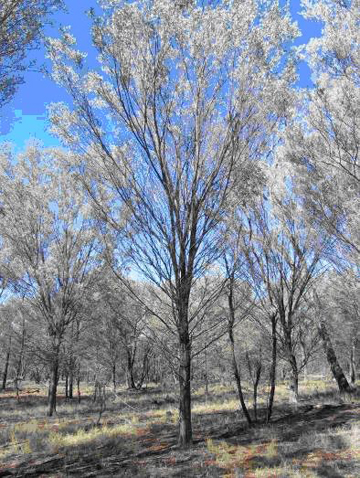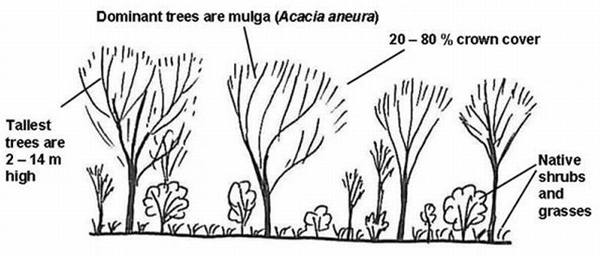Description


What is it?
Mulga is the name given to woodlands and open-forests dominated by the mulga tree (Acacia aneura). So ‘mulga’ is both the name of a plant and a vegetation type.
Where is it?
Mulga occurs in every mainland Australian state except Victoria. In Queensland, mulga is found over a large area of south-west Queensland, roughly bounded in the east and north by Roma, Longreach and Mt Isa.
Carbon potential
The maximum amount of carbon stored by mature mulga increases with average annual rainfall.
The above-ground parts of woody plants in mulga vegetation could store between 30 and 150 tonnes of carbon dioxide equivalent per hectare at a site with 400mm average annual rainfall.
The peak carbon accumulation rate for mulga sites with average annual rainfall above 400mm is 1 to 2 tonnes of carbon dioxide equivalent per hectare per year. Rates of carbon accumulation above ground in regrowing mulga will be greatest in young forests with relatively high rainfall.
Read more about farming carbon and limits to carbon accumulation.
Restoration and management
Rainfall strongly affects the growth and carbon stocks in mulga, but management can also have a large effect.
Grazing by livestock (especially sheep and goats) and macropods (e.g. kangaroos and wallabies) can limit the establishment and growth of small mulga trees, so careful management of grazing is required in the early stage of restoration.
Drought and fire are the greatest risk to carbon stored in mulga, but mulga typically supports limited fine fuels so fire is only likely to be a regular issue in young regrowth or where high densities of exotic grasses are present, which is mainly in the eastern Mulga Lands. Fire risk is generally highest in mulga after good wet seasons.
Livestock grazing can be compatible with reforestation in mulga, as long as grazing pressure is held at low to moderate levels and there is enough strategic spelling (periods where grazing is stopped) to allow new trees to establish.
Increasing the number of trees will reduce the carrying capacity for grazing.
Wildlife
Regrowing mulga will benefit biodiversity, especially such animals as small song birds that are strongly dependent upon ‘mature’ mulga for habitat.
Features


Generally, mature mulga vegetation in Queensland has the following features:
- Mulga (Acacia aneura) is the most prominent woody plant, forming a canopy between about 2m and 14m tall, often with other trees or shrubs.
- Eucalypts like poplar box (Eucalyptus populnea), silver-leaved ironbark (E. melanophloia) and gum-barked coolibah or forest-gum (E. intertexta) are important canopy species in more productive areas.
- Other eucalypts that occur in mulga country include Yapunyah (E. ochrophloia) and Napunyah (E. thozetiana) and River Red Gum (E. camaldulensis).
- Canopy cover can vary from 20% to 80%.
- Mulga occurs on red earth plains, sand plains or on harder shallow soils
Mulga is one of Australia’s most iconic and widespread plant species, occurring in every mainland Australian state except Victoria.
In Queensland, mulga is characteristic of a wide range of arid and semi-arid vegetation communities, from low and open shrublands on stony soils, to open forests 10m or more tall occupying deep soils on extensive red earth plains. It often co-occurs with eucalypts, other acacias and various other arid shrubs and trees.
Mulga is mainly in the Mulga Lands in Queensland’s southwest, but also extends north through the western Mitchell Grass Downs and west into the Channel Country.


More information
View the Mulga Management Guideline .


